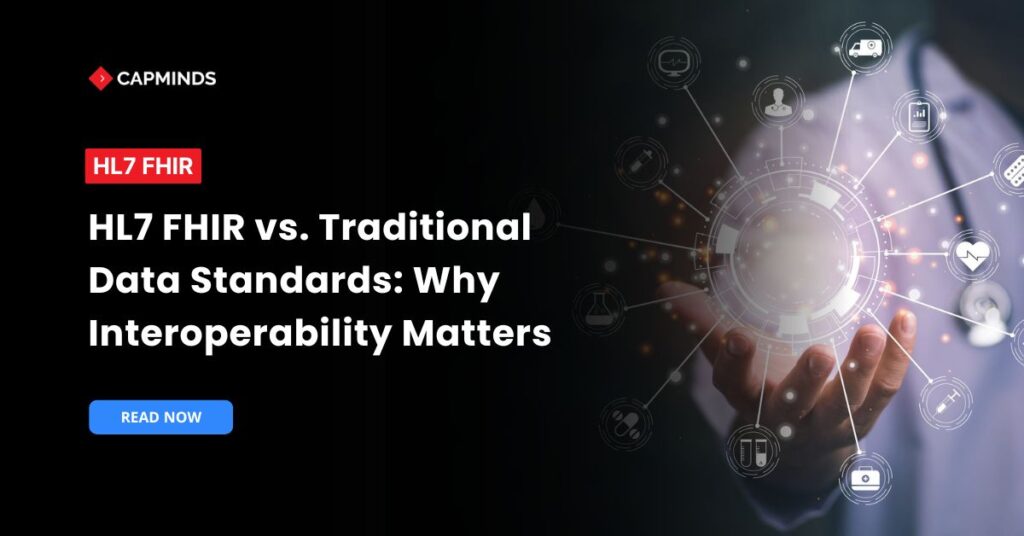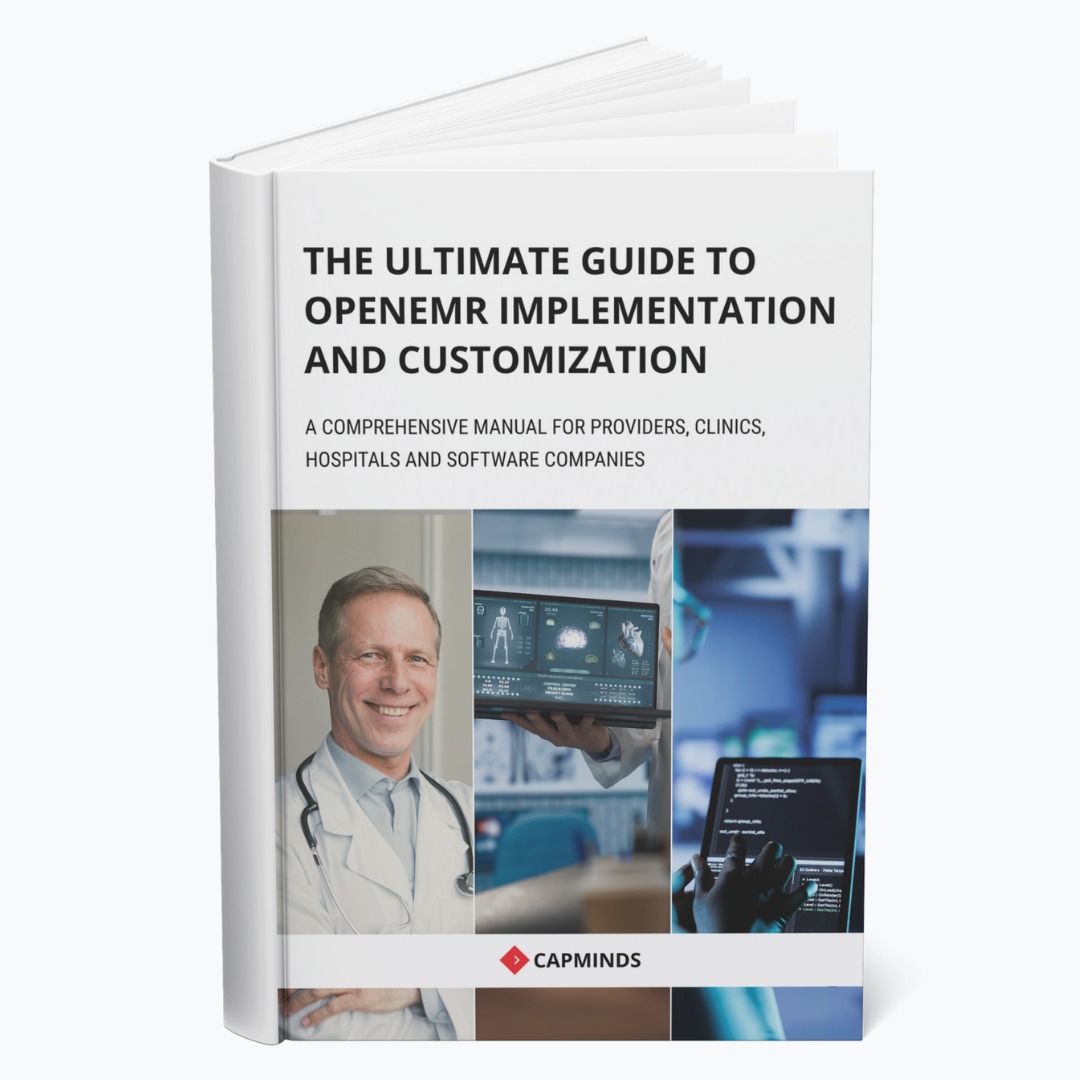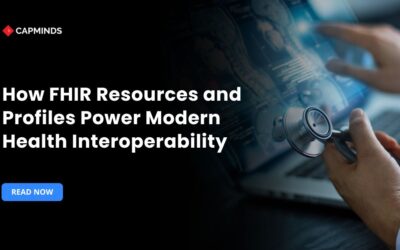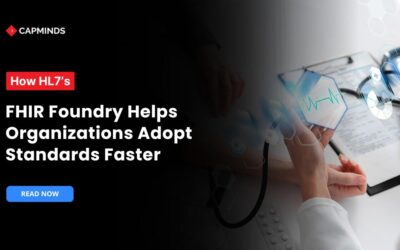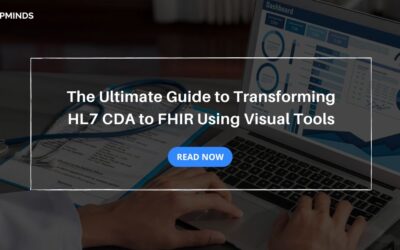HL7 FHIR vs. Traditional Data Standards: Why Interoperability Matters
Interoperability allows healthcare systems to exchange data efficiently and securely. Traditional data standards help, but they have major limitations. HL7 FHIR is a new approach that improves healthcare data sharing. In this blog post, we have shared why health interoperability matters and the comparison between HL7 FHIR and Traditional Data Standards.
What Are Traditional Data Standards?
Traditional data standards help hospitals exchange medical data between systems. They define formats for sharing patient information across different healthcare organizations.
Over time, standards like HL7 V2, and V3 were developed. These standards became widely used but presented serious implementation challenges.
HL7 Version 2
- HL7 V2 was introduced in the late 1980s for hospitals.
- It uses message-based communication to exchange healthcare data across systems.
- Each message contains structured information for a specific medical event.
- However, implementation varies widely across hospitals and healthcare providers.
HL7 Version 3 and Clinical Document Architecture
- HL7 V3 introduced a more structured approach to healthcare data exchange.
- Clinical Document Architecture (CDA) allows the transfer of medical documents.
- CDA defines how electronic health records should be formatted correctly.
- Adoption of HL7 V3 has been slow due to complexity.
Limitations of Traditional Healthcare Data Standards
Traditional healthcare data standards have several challenges that affect efficiency.
1. Complexity in Implementation
- Traditional standards require specialized knowledge for successful implementation in hospitals.
- Healthcare organizations must invest heavily in training their technical teams.
- Integration with modern applications is difficult and time-consuming for providers.
- Customization is often needed to achieve full system compatibility.
2. Limited Flexibility
- Older standards were designed for legacy systems in healthcare.
- These standards struggle to support cloud-based and mobile applications.
- Healthcare technology is evolving, but traditional standards remain unchanged.
- Adapting to new healthcare innovations requires costly upgrades and changes.
3. Interoperability Barriers
- Different hospitals interpret HL7 V2 messages in unique ways.
- Additional mapping tools are needed for effective data exchange.
- Traditional standards lack real-time capabilities for immediate information access.
- This leads to delays in critical medical decision-making processes.
What is HL7 FHIR?
HL7 established FHIR in 2014 as a health interoperability standard that allows medical data to be shared between multiple healthcare systems, boosting interoperability and promoting better-coordinated patient care. This standard is interoperable with various healthcare systems, including:
- Electronic Health Records and Laboratory Information Systems
- Hospital Information System
- Radiology Information Systems
HL7 FHIR standards improve interoperability and are expected to save national healthcare spending. FHIR uses modern web technologies to make data exchange easier. Key benefits of HL7 FHIR Include:
- Uses web-based technologies like RESTful APIs, JSON, and XML.
- Enables real-time access to patient records and healthcare data.
- Designed to work across various healthcare applications and platforms.
- Easy to implement with existing electronic health record (EHR) systems.
Related: 10 Reasons Why You Need CapMinds’ HL7 FHIR Service for Your Practice
Key Features of HL7 FHIR
1. Resource-Based Architecture
- FHIR structures data into reusable units called “resources” for sharing.
- Each resource represents specific healthcare data like patients or medications.
- These resources can be easily combined to build complete records.
- Standardized resources reduce inconsistencies in healthcare data exchange.
2. RESTful APIs for Seamless Integration
- FHIR uses RESTful APIs to transfer healthcare data between systems.
- REST APIs allow applications to request and retrieve patient information.
- Real-time data exchange improves the speed of medical decision-making.
- Healthcare providers can access updated information at any time.
3. Compatibility with Mobile and Cloud-Based Applications
- FHIR supports modern technologies like mobile health and cloud computing.
- It enables easy integration with wearable devices and remote monitoring.
- Patients can securely access medical records through mobile applications.
- This improves convenience for both healthcare professionals and patients.
4. Global Adoption and Support
- Major technology companies like Apple and Google support FHIR integration.
- Government regulations are pushing for FHIR adoption across healthcare.
- Hospitals worldwide are transitioning to FHIR for better efficiency.
- Increased adoption ensures improved healthcare data accessibility for everyone.
Learn More: CapMinds HL7 FHIR
HL7 FHIR vs. Traditional Data Standards: A Detailed Comparison
| Feature | Traditional Standards (HL7 V2/V3, CDA) | HL7 FHIR |
| Data Exchange | Uses batch processing for data transfers in healthcare. | Enables real-time data sharing across multiple systems. |
| Implementation Complexity | Requires significant effort to customize and integrate correctly. | Easier to implement using modern web-based technologies. |
| Integration | Difficult to connect with cloud-based healthcare applications. | Works seamlessly with mobile and cloud healthcare platforms. |
| Interoperability | Needs additional tools for complete data standardization. | Designed for direct and efficient data sharing. |
| Adoption Rate | Still widely used but facing modern system challenges. | Rapidly gaining adoption among hospitals and developers. |
Why Interoperability Matters in Healthcare
Interoperability ensures healthcare professionals can exchange patient data effectively.
Related: The Complete Guide to FHIR Integration for Healthcare Data and ROI
Challenges Caused by the Lack of Interoperability
1. Fragmented patient records across hospitals and providers.
- Patient records often remain segregated across multiple healthcare systems.
- Providers lack full visibility into a patient’s medical history.
- Incomplete data leads to misdiagnoses and incorrect treatments.
- Fragmented records prevent smooth coordination between healthcare providers.
2. Delayed access to critical medical information.
- Emergencies require instant access to patient medical data.
- Traditional data exchange methods cause unnecessary delays for providers.
- Faster data retrieval improves treatment accuracy and response times.
- FHIR allows immediate access to patient records when needed.
3. Increased chances of medical errors due to inconsistent data.
- Inaccurate patient data leads to incorrect prescriptions and treatments.
- Duplicate tests occur due to a lack of system-wide data availability.
- Miscommunication between providers results in harmful medical decisions.
- Better data standardization reduces errors in medical documentation.
4. Higher operational costs for healthcare providers.
- Manual data entry increases the administrative workload for hospitals.
- Poor interoperability results in extra costs for system upgrades.
- Unnecessary repeat tests add expenses to healthcare organizations.
- Improved data exchange lowers costs and boosts efficiency.
How HL7 FHIR Solves These Problems
1. Enables seamless data sharing across different healthcare platforms.
FHIR’s structured resources simplify secure data exchange between systems. Providers can access full patient records across different locations. This ensures accurate and consistent medical data availability. Improved data sharing leads to better patient care overall.
2. Facilitates real-time patient data access for healthcare professionals.
RESTful APIs enable instant retrieval of medical information. Providers can make informed decisions based on real-time data. Urgent care scenarios benefit from immediate record accessibility. FHIR enhances speed and accuracy in healthcare communication.
3. Improves patient engagement through mobile health apps.
Patients can view and manage medical data through secure apps. Mobile health applications integrate easily with FHIR technology. Users gain better control over personal health records. Improved access to data encourages proactive health management.
4. Supports AI and analytics integration for better healthcare decision-making.
AI-driven analytics depend on accurate and standardized healthcare data. FHIR enables predictive healthcare insights through structured resources. Practices can use AI to identify risks and recommend treatments. Data-driven decision-making leads to better medical outcomes.
CapMinds HL7 FHIR Service for Healthcare Practice
CapMinds offers the best all-in-one health interoperability solution for healthcare practices. Our HL7 FHIR service will understand your clinical needs and requirements to cater to our solution.
We have years of experience in this field faced many challenges and tackled them with ease. Why can CapMinds be your Go-to Interoperability Solution?
- We are experienced professionals with years of experience in the field.
- Our technical team is an expert who will analyze your healthcare practice thoroughly to tailor the Interoperability solution.
- We prioritize safety, security, encryption, and authentication to protect your healthcare practice patient’s data.
- Our comprehensive solution ensures seamless interoperability adhering to industry standards, and using standard protocols.
- We offer comprehensive training sessions to healthcare staff.
- Our affordable health interoperability solution benefits healthcare practice at all levels.
If you are searching for the best interoperability service for your practice, CapMinds is your choice. We can assist you by navigating all potential challenges and ensuring seamless health data exchange.
Reach out to CapMinds Health Data Exchange Solutions for your Healthcare Practice.
